Natural and Engineered Ocean Inflow Projects to Improve Water Quality Through Increased Exchange
Abstract
1. Introduction
- a culvert with a flap gate.
- Examples of two-way flow structures are
2. Existing Projects
- 1.
- Barrier island breech at Fire Island, New York, USA;
- 2.
- Intermittently Closed and Opened Lakes and Lagoons (ICOLLs) in New South Wales Australia;
- 3.
- Hydraulic pumping of ocean water into Destin Harbor, Florida, USA;
- 4.
- Restoring tidal exchange in a coastal lake at Lake Veere, the Netherlands;
- 5.
- Establishing ocean exchange at Ringkobing Fjord, Denmark.
2.1. Fire Island, New York, USA
2.1.1. Introduction to the Location
2.1.2. Results of the Natural Opening
2.2. Various ICOLLs in New South Wales (NSW), AU
2.2.1. Introduction to the Locations
2.2.2. Results of Artificial Openings at Belongil Creek
2.2.3. Results of the Natural Opening at Lake Woolgoolga
2.2.4. Results of Natural Openings (Other)
2.3. Destin Harbor, Florida, USA
2.3.1. Introduction to the Location
2.3.2. Results of the Intervention
2.4. Lake Veere, the Netherlands
2.4.1. Introduction to the Location
2.4.2. Results of the Intervention
2.5. Ringkobing Fjord, Denmark
2.5.1. Introduction to the Location
2.5.2. Results of the Intervention
3. Synthesis of Location Data
4. Conclusions
Author Contributions
Funding
Institutional Review Board Statement
Informed Consent Statement
Data Availability Statement
Conflicts of Interest
References
- Smith, V.H. Eutrophication of freshwater and coastal marine ecosystems a global problem. Environ. Sci. Pollut. Res. 2003, 126–139. [Google Scholar] [CrossRef] [PubMed]
- United Nations. International Decade for Action ‘WATER FOR LIFE’ 2005–2015. 2014. Available online: https://www.un.org/waterforlifedecade/quality.shtml (accessed on 15 March 2022).
- Bassem, S. Water Pollution and Aquatic Biodiversity. Environ. Sci. 2020, 4, 10–16. [Google Scholar]
- UNESCO. International Initiative on Water Quality (IIWQ). 2019. Available online: https://en.unesco.org/waterquality-iiwq/wq-challenge#:~:text=One%20in%20nine%20people%20worldwide%20uses%20drinking%20water%20from%20unimproved%20and%20unsafe%20sources&text=2.4%20billion%20people%20live%20without%20any%20form%20of%20sanitation&text=Lack% (accessed on 9 September 2022).
- Stewart, J.; Virnstein, R.; Haunert, D.; Lund, F. Surface Water Improvement and Management (SWIM) Plan for the Indian River Lagoon; St. Johns Water Management District and South Florida Water Management District: Palatka, FL, USA, 1989. [Google Scholar] [CrossRef]
- Salzamn, J.E., Jr.; Thompson, B.H.T. Envinonmental Law and Policy; Foundation Press: New York, NY, USA, 2019. [Google Scholar]
- Kanakidou, M.; Myriokefalitakis, S.; Daskalakis, N.; Fanourgakis, G.; Nenes, A.; Baker, A.; Tsigaridis, K.; Past, N.M. Present and Future Atmospheric Nitrogen Deposition. J. Atmos Sci. 2016, 73, 2039–2047. [Google Scholar] [CrossRef] [PubMed]
- Harbor Branch, “IRL Information”. 2022. Available online: https://www.fau.edu/hboi/research/marine-ecosystem-conservation/irlo/outreach/irl-information/ (accessed on 9 November 2022).
- Bridgewater, P.; Guarino, E.; Thompson, R.M. Hydrology in the Anthropocene. Encycl. Anthr. 2017, 1–5, 87–92. [Google Scholar]
- Dagbegnon, C.; Djebou, S.; Singh, V. Impact of climate change on the hydrologic cycle and implications for society. Environ. Sci. 2016, 1, 36–49. [Google Scholar]
- Sigua, G.C.; Steward, J.; Tweedale, W. Water-Quality Monitoring and Biological Integrity Assessment in the Indian River Lagoon, Florida: Status, Trends, and Loadings (1988–1994). Environ. Manag. 2000, 25, 199–209. [Google Scholar] [CrossRef]
- IRLNEP. Looking Ahead to 2030: A 10-Year Comprehensive Conservation and Management Plan (CCMP) for the Indian River Lagoon (IRL); IRL Council and IRLNEP: Sebastian, FL, USA, 2017. [Google Scholar]
- Barile, P.J. Widespread sewage pollution of the Indian River Lagoon system, Florida (USA) resolved by spatial analyses of macroalgal biogeochemistry. Mar. Pollut. Bull. 2018, 128, 557–574. [Google Scholar] [CrossRef]
- Morris, L.J.; Hall, L.M.; Jacoby, C.A.; Chamberlain, R.H.; Hanisak, M.D.; Miller, J.D.; Virnstein, R.W. Seagrass in a Changing Estuary, the Indian River Lagoon, Florida, United States. Front. Mar. Sci. 2022, 8, 789818. [Google Scholar] [CrossRef]
- Philips, E.J.; Badylak, S.; Nelson, N.G.; Hall, L.M.; Jacoby, C.A.; Lasi, M.A.; Lockwood, J.C.; Miller, J.D. Cyclical Patterns and a Regime Shift in the Character of Phytoplankton Blooms in a Restricted Sub-Tropical Lagoon, Indian River Lagoon, Florida, United States. Front. Mar. Sci. 2021, 8, 730934. [Google Scholar] [CrossRef]
- Duarte, C.M.; Krause-Jensen, D. Intervention Options to Accelerate Ecosystem Recovery From Coastal Eutrophication. Front. Mar. Sci. 2018, 5, 470. [Google Scholar] [CrossRef]
- Petersen, J.K.; Hansen, J.W.; Laursen, M.B.; Clausen, P.; Carstensen, J.; Conley, D.J. Regime Shift in a Coastal Marine Ecosystem. Ecol. Appl. 2008, 18, 497–510. [Google Scholar] [CrossRef] [PubMed]
- Nielsen, M.H.; Rasmussen, B.; Gertz, F. A simple model for water level and stratification in Ringkøbing Fjord, a shallow, artificial estuary. Estuar. Coast. Shelf Sci. 2005, 63, 235–248. [Google Scholar] [CrossRef]
- Burgess, M. Destin Harbor Pump. 2020. Available online: https://mydestinlife.com/destin-harbor-pump-ready-for-the-2020-season/ (accessed on 7 January 2023).
- Indian River County. Bethel Creek Community Discussion Meeting. 2016. Available online: https://ircgov.com/Lagoon/Bethel-Creek/Bethel-Workshop-081116.pdf (accessed on 12 January 2023).
- FDEP. DEP 101: Surface Water Quality Standards. 20 March 2023. Available online: https://floridadep.gov/comm/press-office/content/dep-101-surface-water-quality-standards (accessed on 9 April 2023).
- Landers-Atkins Planners, Inc. Destin Harbor Management Plan. 1987. Available online: https://www.govinfo.gov/content/pkg/CZIC-tc225-d47-d47-1987/html/CZIC-tc225-d47-d47-1987.htm (accessed on 23 September 2022).
- Ysebaert, T.; van der Hoek, D.-J.; Wortelboer, R.; Wijsman, J.W.M. Tangelder and A. Nolte. Management options for restoring estuarine dynamics and implications for ecosystems: A quantitative approach for the Southwest Delta in the Netherlands. Ocean. Coast. Manag. 2016, 121, 33–48. [Google Scholar] [CrossRef]
- Wijnhoven, S.; Escaravage, V.; Daemen, E.; Hummel, H. The decline and restoration of a coastal lagoon (Lake Veere) in the Dutch Delta. Estuaries Coasts 2010, 33, 1261–1278. [Google Scholar] [CrossRef][Green Version]
- Coosen, J.; Meire, P.; Stuart, J.; Seys, J. Trophic relationships in brackish Lake Veere: The role of macrophytes. In Proceedings of the 24th European Marine Biology Symposium, Aberdeen, UK, 4–10 October 1990. [Google Scholar]
- Herman, P.; Hemminga, M.; Nienhuis, P.; Verschuure, J.; Wessel, E. Wax and wane of eelgrass Zostera marina and water column silica levels. Mar. Ecol. Prog. Ser. 1996, 144, 303–307. [Google Scholar] [CrossRef]
- Troost, K.; Tangelder, M.; van den Ende, D.; Ysebaert, T. From Past to Present: Biodiversity in a Changing Delta; Statutory Research Tasks Unit for Nature & the Environment: Wageningen, The Netherlands, 2012. [Google Scholar]
- Dowhan, J.; Halavik, T.; Milliken, A.; MacLachlan, A.; Caplis, M.; Lima, K.; Zimba, A. Significant Habitats and Habitat Complexes of the New York Bight Watershed; US Fish and Wildlife Service: Charleston, RI, USA, 1997. [Google Scholar]
- Bilecki, M.S. Fire Island National Seashore: A breach in the barrier island at the Otis Pike Fire Island High Dune Wilderness. Parks Steward. Forum 2020, 36, 137–143. [Google Scholar] [CrossRef]
- Hinrichs, C.; Flagg, C.N.; Wilson, R.E. Great South Bay After Sandy: Changes in Circulation and Flushing due to New Inlet. Estuaries Coasts 2018, 41, 2172–2190. [Google Scholar] [CrossRef]
- Olin, J.A.; Cerrato, R.M.; Nye, J.A.; Sagarese, S.R.; Sclafani, M.; Zacharias, J.P.; Frisk, M.G. Evidence for Ecosystem Changes Within a Temperate Lagoon Following a Hurricane-Induced Barrier Island Breach. Estuaries Coasts 2020, 43, 1625–1639. [Google Scholar] [CrossRef]
- NPS. Monitoring the Wilderness Breach. 2018. Available online: https://www.nps.gov/fiis/learn/nature/monitoring-the-wilderness-breach.htm (accessed on 2 February 2023).
- NPS; USACE. Final Fire Island Wilderness Breach Management Plan/Environmental Impact Statement. 2017. Available online: https://parkplanning.nps.gov/showFile.cfm?projectID=58824&MIMEType=application%252Fpdf&filename=FIIS%5FFEIS%5FFinal%5F508%5FEPA%5FPEPC%5FFile%5FDec2017%2Epdf&sfid=308208 (accessed on 4 February 2023).
- National Park Service. Post-Hurricane Sandy: Old Inlet Breach on Fire Island. 13 January 2013. Available online: https://web.archive.org/web/20130113205614/http://www.nps.gov/fiis/naturescience/post-hurricane-sandy-breaches.htm (accessed on 27 January 2023).
- National Park Service. The Fire Isalnd Wilderness Breach: Water Quality and Levels. 20 December 2016. Available online: https://www.nps.gov/articles/the-fire-island-wilderness-breach-water-quality-and-levels.htm (accessed on 18 January 2023).
- NSW Department of Planning and Envionment. Woolgoolga Lake. 27 November 2023. Available online: https://www.environment.nsw.gov.au/topics/water/estuaries/estuaries-of-nsw/woolgoolga-lake (accessed on 8 January 2024).
- NSW Department of Planning and Environment. Belongil Creek. 2 May 2023. Available online: https://www.environment.nsw.gov.au/topics/water/estuaries/estuaries-of-nsw/belongil-creek (accessed on 8 January 2024).
- NSW Government. Habitat Management–Wetland Habitats. February 2023. Available online: https://www.dpi.nsw.gov.au/fishing/habitat/aquatic-habitats/wetland/coastal-wetlands/management-of-coastal-lakes-and-lagoons-in-nsw (accessed on 8 January 2024).
- NSW Government. Health of Our Estuaries. 14 December 2021. Available online: https://www.environment.nsw.gov.au/topics/water/estuaries/estuaries-of-nsw/tallow-creek (accessed on 11 May 2023).
- Mayjor, M.; Reichelt-Brushett, A.J.; Malcolm, H.A.; Page, A. Water quality fluctuations in small intermittently closed and open lakes and lagoons (ICOLLs) after natural and artificial openings. Estuar. Coast. Shelf Sci. 2023, 281, 132–146. [Google Scholar] [CrossRef]
- Ferguson, A.; Wiecek, D.; Hughes, M.; Hanslow, D.; Wainwright, D.; Scanes, P. Form and Function of NSW Intermittently Closed and Open Lakes and Lagoons. Environment, Energy and Science; Department of Planning, Industry and Environment: Parramatta, NSW, Australia, 2021. [Google Scholar]
- Byron Shire Council. Belongil Creek. 2022. Available online: https://www.byron.nsw.gov.au/Services/Environment/Coast-and-waterways/Estuaries-and-ICOLLs/Belongil-Creek (accessed on 12 March 2023).
- Ivezich, M.; Teague, J.; Wainwright, D.; Skull, S. Belongil Creek Entrance Opening Strategy; Byron Shire Council: Mullumbimby, NSW, Australia, 2021. [Google Scholar]
- Cavanagh, D.; Visser, J.; Richards, S.; Ainsworth, J. Review of Environmental Factors: Tallow Creek Entrance Opening–Vol. 1; BMT WBM: Brisbane, Australia, 2015. [Google Scholar]
- Benkendorff, K.; Klaas, C.; Kirby, M. Water Quality in Woolgoolga Estuary and Valuation of Nutrient Removal Servies by the Remnant Leaf Oyster Reef; Coffs Harbour City Council–Environmental Levy Program: Coffs Harbour, NSW, Australia, 2022. [Google Scholar]
- Hyman, A.C.; Stephens, D.B. Effects of seawater exchange on water chemistry among coastal lakes with intermittent connections to the sea. Estuar. Coast. Shelf Sci. 2020, 244, 106934. [Google Scholar] [CrossRef]
- Elwany, M.H.S.; Flick, R.E.; Aijaz, S. Opening and closure of a marginal Southern California lagoon inlet. Estuaries 1998, 21, 246–254. [Google Scholar] [CrossRef][Green Version]
- Kraus, N.C.; Militello, A.; Todorf, G. Barrier Breaching Processes and Barrier Spit Breach, Stone Lagoon, California. Shore Beach 2002, 70, 21–28. [Google Scholar]
- Whitfield, A.; Bate, G. A review of information on temporarily open/closed estuaries in the warm and cool temperate biogeographic regions of South Africa, with particular emphasis on the influence of river flow on these systems. Water Res. Com. 2007, 158, 7. [Google Scholar]
- Perissinotto, R.; Stretch, D.D.; Whitfield, A.K.; Adams, J.; Forbes, A.T.; Demetriades, N.T. Temporarily Open/Closed Estuaries in South Africa; Nova Science Publishers: Novinka, Russia, 2010. [Google Scholar]
- Maher, W.; Mikac, K.; Foster, S.; Spooner, D.; Williams, D. Form and functioning of micro size intermittent closed open lake lagoons (ICOLLs) in NSW, Australia. In Lagoons: Biology, Management and Environmental Impact; Nova Science Publishers, Inc.: New York, NY, USA, 2011; pp. 119–152. [Google Scholar]
- Kinnear, J.A.; Binley, A.; Duque, C.; Engesgaard, P.K. Using geophysics to map areas of potential groundwater discharge into Ringkøbing Fjord, Denmark. Lead. Edge 2013, 32, 725–856. [Google Scholar] [CrossRef]
- USACE Jacksonville District. St. Lucie Inlet FL (O&M) Congressional Fact Sheet; USACE: Jacksonville, FL, USA, 2023. [Google Scholar]
- Jupiter Inlet District. Inlet Dredging Project. 2023. Available online: https://www.jupiterinletdistrict.org/2023-jupiter-inlet-district-inlet-dredging-project (accessed on 28 November 2023).
- Gray, J. 10 FAQS–Sebastian Inlet District’s Channel Maintenance Dredging, Sand Bypass and Beach Renourishment Project. 9 March 2019. Available online: https://www.sitd.us/10-faqs-sebastian-inlet-district-s-channel-maintenance-dredging-sand-bypass-and-beach-renourishment-project (accessed on 10 September 2022).
- Remillard, J.; McDivitt, P.; Druschke, C.G. The Fire Island Wilderness Breach: Ecological Resilience in Great South Bay; National Park Service: Patchogue, NY, USA, 2017. [Google Scholar]
- Ghosh, A.K.; Pattnaik, A.K.; Ballatore, T.J. Chilika lagoon: Restoring ecological balance and livelihoods through re-salinization. Lakes Reserv. Sci. Policy Manag. Sustain. Use 2006, 11, 239–255. [Google Scholar] [CrossRef]
- Schallenberg, M.; Larned, S.T.; Hayward, S.; Arbuckle, C. Contrasting effects of managed opening regimes on water quality in two intermittenly closed and open coastal lakes. Estuar. Coast. Shelf Sci. 2010, 86, 587–597. [Google Scholar] [CrossRef]
- Li, Y.; Tang, C.; Wang, C.; Anim, D.; Yu, Z.; Acharya, K. Improved Yangtze River Diversions: Are they helping to solve algal bloom problems in Lake Taihu, China? Ecol. Eng. 2013, 51, 104–116. [Google Scholar] [CrossRef]
- Humphries, R.; Robinson, S. Assessment of the success of the peel-harvey estuary system management strategy- a western Australian attempt at integrated catchment management. Water Sci. Technol. 1995, 32, 255–264. [Google Scholar] [CrossRef]
- Lillebo, A.I.; Neto, J.M.; Martins, L.; Verdelhos, T.; Leston, S.; Cardoso, P.G. Management of a shallow temperate estuary to control eutrophication: The effect of hydrodynamics on the system’s nutrient loading. Estuar. Coast. Shelf Sci. 2005, 65, 697–707. [Google Scholar] [CrossRef]
- Port of Los Angeles Engineering Division. Inner Cabrillo Beach Water Quality Improvement Project Source Identifications and Mitigation Alternatives. 2006. Available online: https://faast.waterboards.ca.gov/attachments/proposal_18975/attachment_61567.pdf (accessed on 20 October 2022).
- Nixon, S.; Ammerman, J.; Atkinson, L.; Berounsky, V.; Billen, G.; Boicourt, W.; Boynton, W.; Church, T.; Ditoro, D.; Elmgren, R.; et al. The fate of nitrogen and phosphorus at the land-sea margin of the North Atlantic Ocean. Biogeochemistry 1996, 35, 141–180. [Google Scholar] [CrossRef]
- Kemp, W.; Testa, J.; Conley, D.; Gilbert, D.; Hagy, J. Coastal hypoxia responses to remediation. Biogeosciences 2009, 6, 6889–6948. [Google Scholar]
- Hinga, K.R. Water Quality and Ecology of Great South Bay (Fire Island National Seashore Science Synthesis Paper); National Park Service: Boston, MA, USA, 2005. [Google Scholar]
- NYSDEC. South Shore Estuary Reserve. 2023. Available online: https://www.dec.ny.gov/lands/31847.html (accessed on 17 May 2023).
- Judnich, T. ‘World’s Luckiest Fishing Village’: Multi-Pronged Destin Harbor Study Could Wrap Up in 22. 28 July 2021. Available online: https://www.nwfdailynews.com/story/news/local/2021/07/28/destin-harbors-environmental-public-safety-economic-health-study/8040254002/ (accessed on 21 November 2022).
- Ramsar. Veerse Meer. 1 November 2022. Available online: https://rsis.ramsar.org/ris/1251 (accessed on 8 November 2022).
- Basemap; ArcGIS Pro 3.3.0; Environmental Systems Research Institute (ESRI): Redlands, CA, USA, 2024.
- National Park Service, US Department of the Interior. Planning, Environment & Public Comment. December 2017. Available online: https://parkplanning.nps.gov/document.cfm?parkID=227&projectID=58824&documentID=84750 (accessed on 3 February 2023).
- Methratta, E.T.; Pacelli, C.L.; Fields, L.; Bosma, K.; Clark, H.J. Technical Synthesis Report for Physical and Ecological Resources at Fire Island National Seashore; NPS: Fort Collins, CO, USA, 2017. [Google Scholar]
- Gobler, C.J.; Young, C.S.; Goleski, J.; Stevens, A.; Thickman, J.; Wallace, R.B.; Curran, P.; Koch, F.; Kang, Y.; Lusty, M.W.; et al. Collier. Accidental ecosystem resotration? Assessing the estuary-wide impacts of a new ocean inlet created by Hurricane Sandy. Estuar. Coast. Shelf Sci. 2019, 221, 132–146. [Google Scholar] [CrossRef]
- Gobler, C.J.; Collier, J.; Lonsdal, D. Assessing the Response of the Great South Bay Plankton Community to Hurricane Sandy; SUNY Stony Brook: New York, NY, USA, 2014. [Google Scholar]
- Harris, L.; Hodgkins, C.; Day, M.; Austin, D.; Testa, J.; Boynton, W.; Van Der Tak, L.; Chen, N. Optimizing recovery of eutrophic estuaries: Impact of destratification and re-aeration on nutrient and dissolved oxygen dynamics. Ecoloical Eng. 2015, 75, 470–483. [Google Scholar] [CrossRef]
- Northwest Florida Water Management District. Permit Re-Application for the Old Pass Lagoon Yater Circulation Facility; Northwest Florida Water Management District: Havana, FL, USA, 1992. [Google Scholar]
- Shen, J.; Du, J.; Lucas, L.V. Simple relationships between residence time and annual nutrient retention, export, and loading for estuaries. Limnol. Oceanogr. 2022, 67, 918–933. [Google Scholar] [CrossRef]
- Diaz, R.J.; Rosenberg, R. Spreading Dead Zones and Consequences for Marine Ecosystems. Science 2008, 321, 926–929. [Google Scholar] [CrossRef]
- Hakanson, L.; Bryhn, A.C. Goals and remedial strategies for water quality and wildlife management in a coastal lagoon—A case-study of Ringkobing Fjord, Denmark. J. Environ. Manag. 2008, 86, 498–519. [Google Scholar] [CrossRef]
- Dettmann, E.H. Effect of water residence time on annual export and denitrification of nitrogen in estuaries: A model analysis. Estuaries Coasts 2001, 24, 481–490. [Google Scholar] [CrossRef]
- Vollenweider, R.A. Input-output models With special reference to the phosphorus loading concept in limnology. Aquat. Sci. 1975, 37, 53–84. [Google Scholar] [CrossRef]



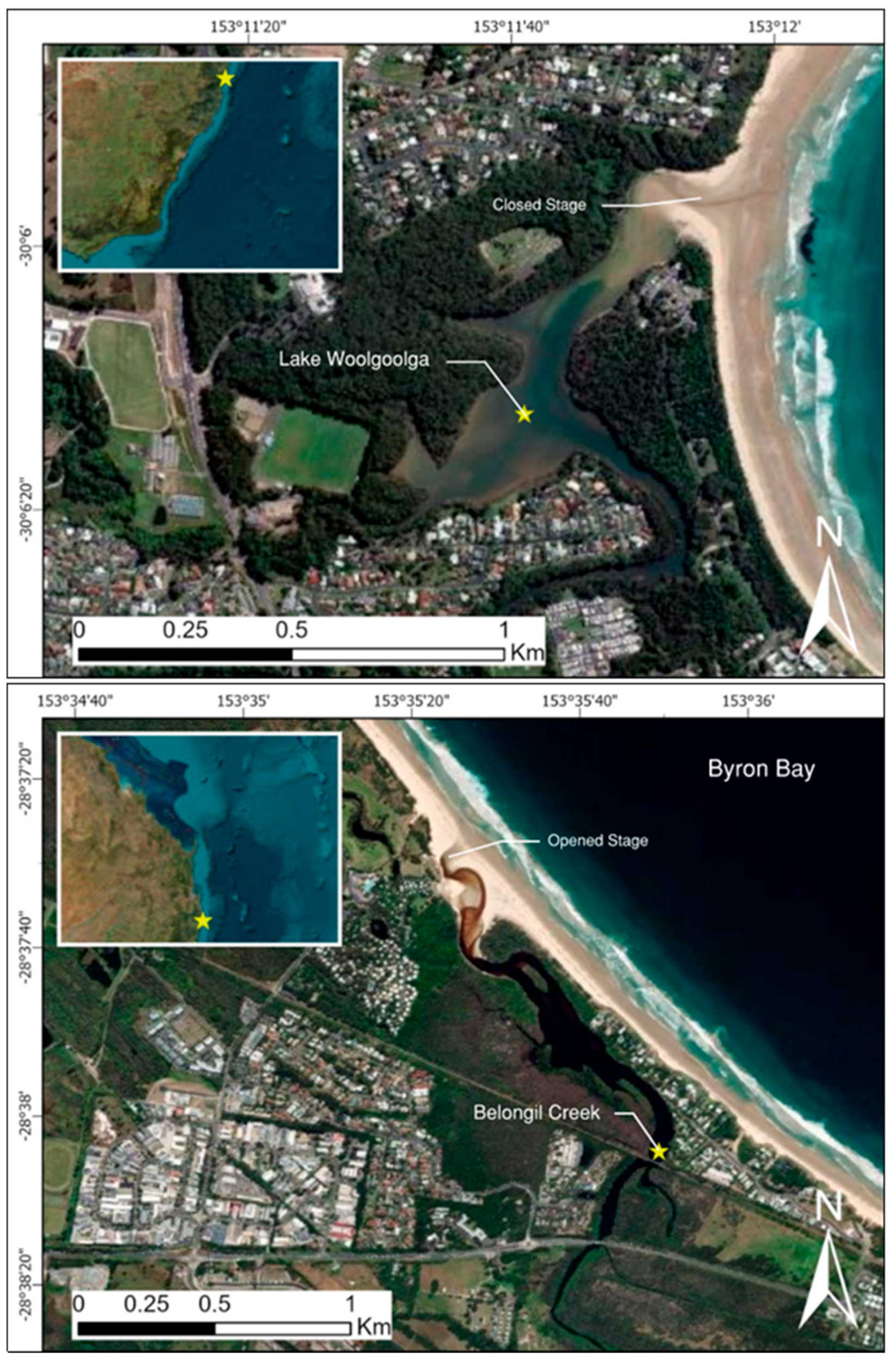

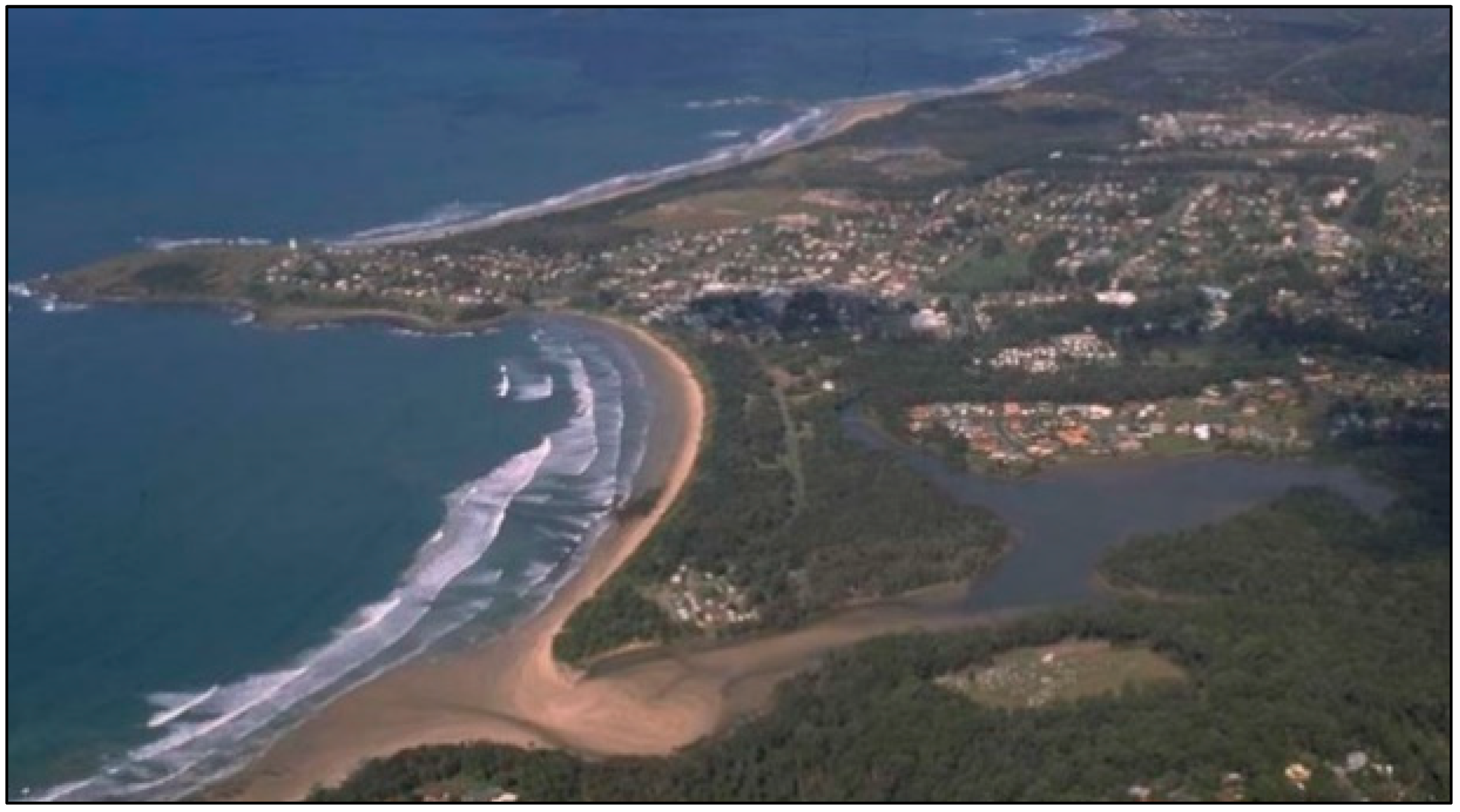
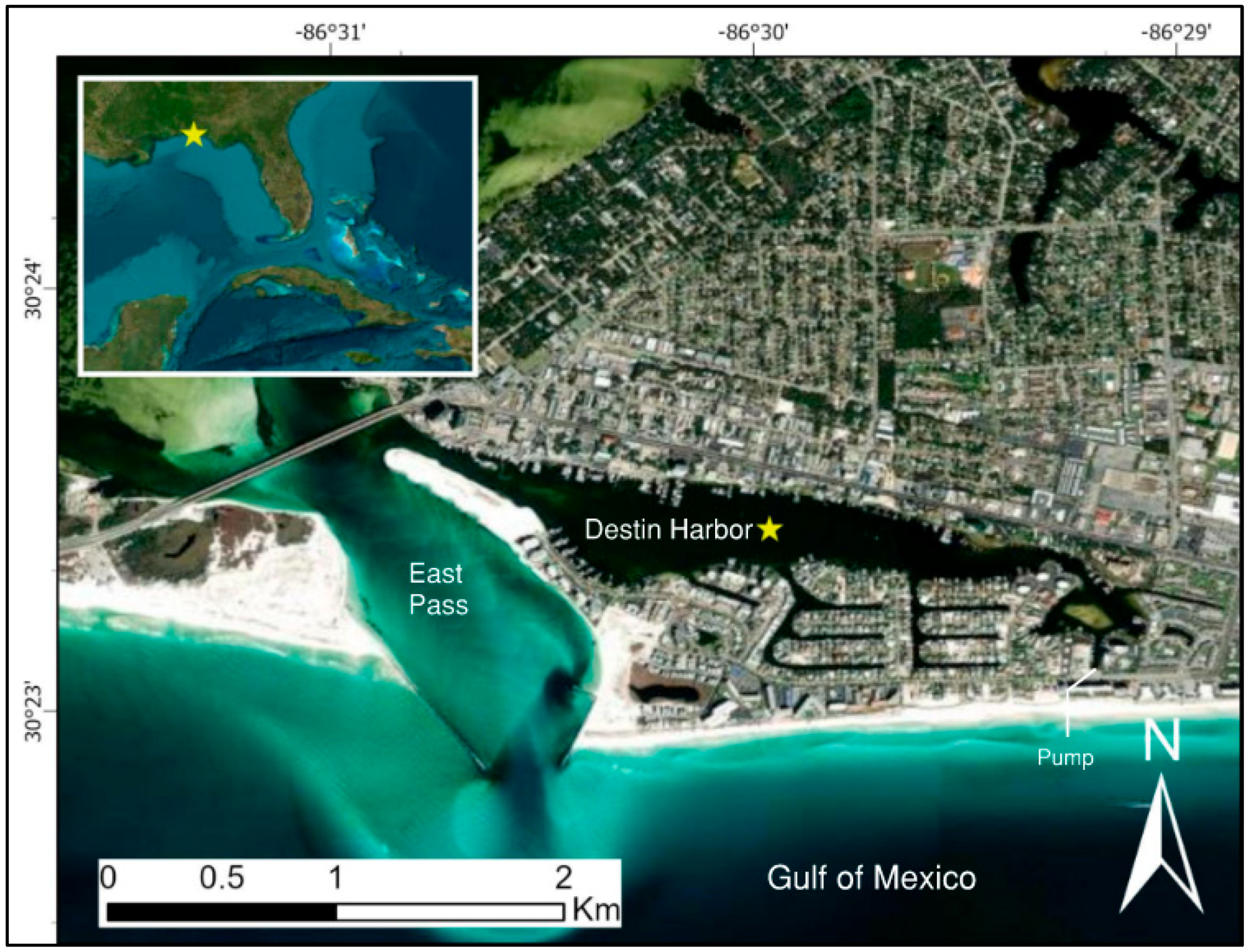
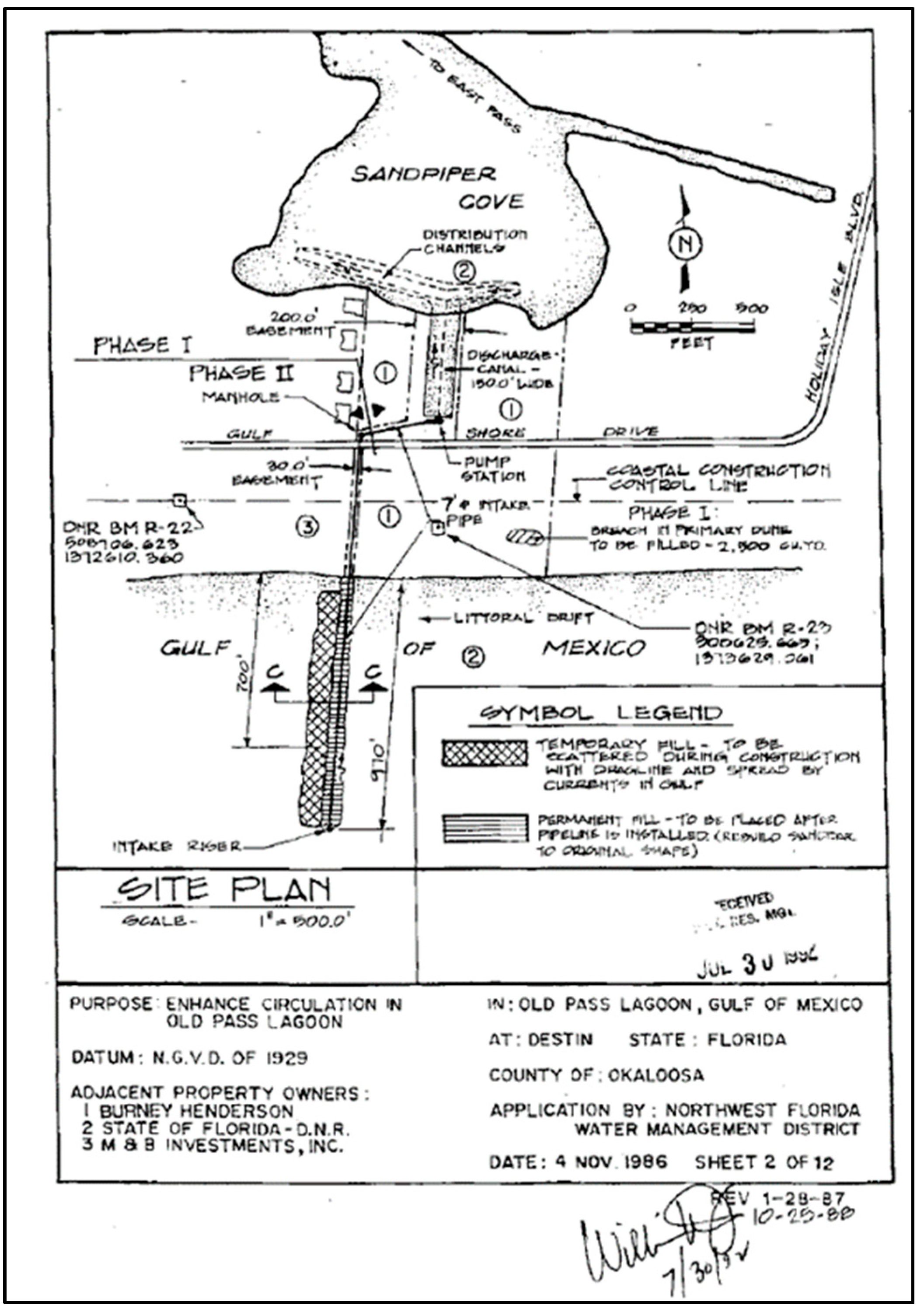


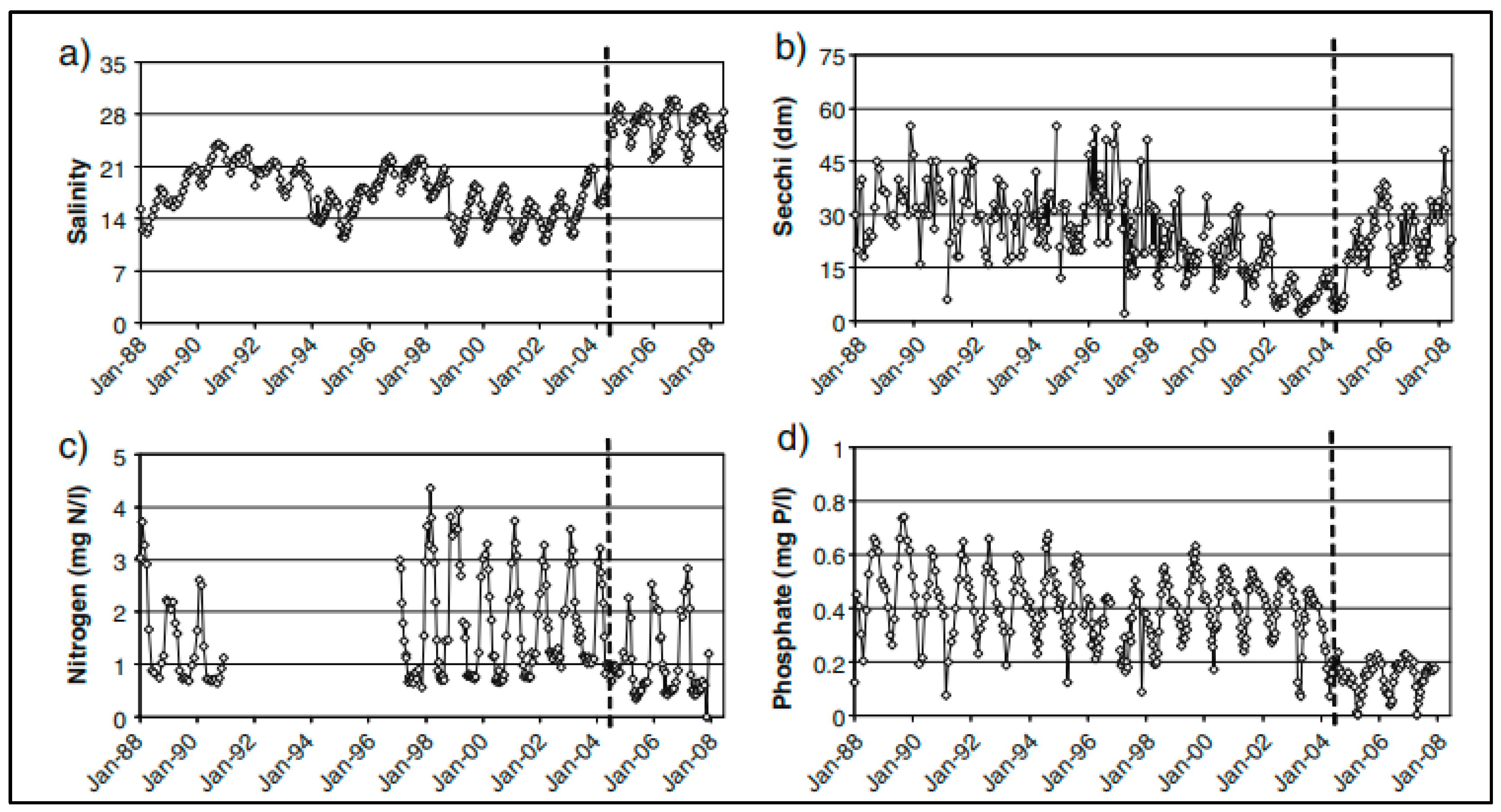
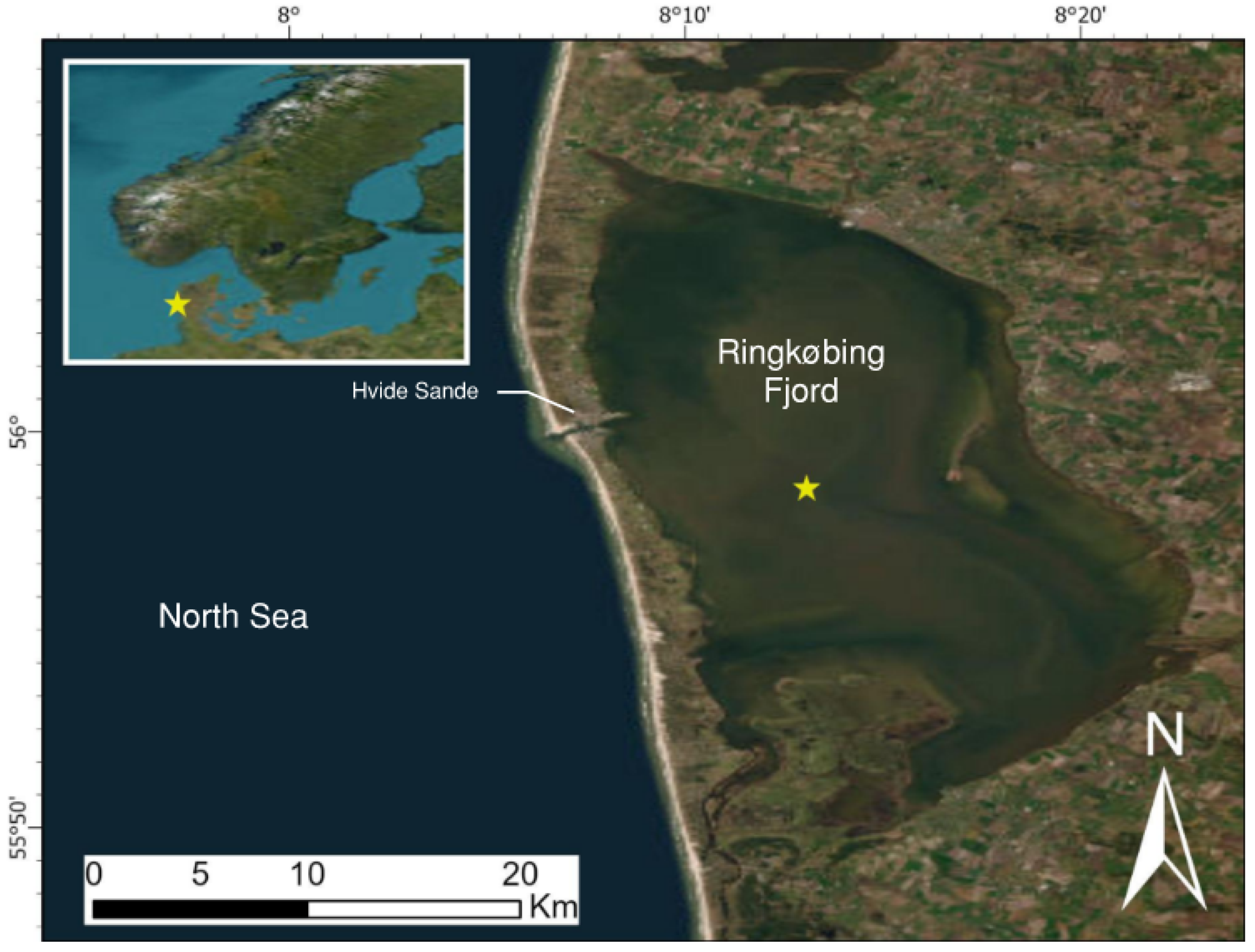

| Name | Location | Type of Water Body | Surface Area | Average Depth | Opening Mechanism | Catchment Area |
|---|---|---|---|---|---|---|
| Great South Bay | NY, USA | Shallow Saltwater Lagoon [28] | 390 km2 [28] | 1.3 m [65] | Naturally breached inlet [29] | 844 km2 [66] |
| Belongil Creek | NSW, AUS | ICOLL [41] | 0.3 km2 [37] | 0.5 m [40] | Mechanically opened temporary inlet [41] | 30 km2 [37] |
| Lake Woolgoolga | NSW, AUS | ICOLL [38] | 0.2 km2 [40] | 0.4 m [38] | Naturally opened temporary inlet [40] | 21 km2 [38] |
| Destin Harbor | Destin, FL, USA | Saltwater Lagoon [22] | 0.85 km2 [67] | 5.3 m [67] | Restricted opening with mechanical pumping [19] | 4 km2 [19] |
| Lake Veere | South-western NLD | Artificially Managed Lagoon | 24.4 km2 [23] | 10 m [24] | Managed tidal gate [25] | Varies based on the pumping schedule from surrounding polders [68] |
| Ringkobing Fjord | Western DNK | Shallow Coastal Lagoon | 300 km2 [18] | 2–3 m [17] | Managed Tidal Sluice [17] | 3500 km2 [52] |
| Evaluation Criteria | Fire Island, NY, USA | NSW, AU | Lake Veere, NL | Destin Harbor, FL, USA | Ringkobing Fjord, DK |
|---|---|---|---|---|---|
| Decreased Nutrient (N, P) Concentrations | x | - | x | - | x |
| Increased Dissolved Oxygen | x | x | x | x | x |
| Reduction/stabilization of temperature | x | x | - | - | - |
| Increase/stabilization of salinity | x | - | - | - | - |
| Reduction in turbidity/increase in water clarity | x | - | - | x | x |
| Increase in flora/fauna diversity and abundance | x | - | x | x | x |
Disclaimer/Publisher’s Note: The statements, opinions and data contained in all publications are solely those of the individual author(s) and contributor(s) and not of MDPI and/or the editor(s). MDPI and/or the editor(s) disclaim responsibility for any injury to people or property resulting from any ideas, methods, instructions or products referred to in the content. |
© 2024 by the authors. Licensee MDPI, Basel, Switzerland. This article is an open access article distributed under the terms and conditions of the Creative Commons Attribution (CC BY) license (https://creativecommons.org/licenses/by/4.0/).
Share and Cite
Komita, B.; Weaver, R.; McClain, N.; Fox, A. Natural and Engineered Ocean Inflow Projects to Improve Water Quality Through Increased Exchange. J. Mar. Sci. Eng. 2024, 12, 2047. https://doi.org/10.3390/jmse12112047
Komita B, Weaver R, McClain N, Fox A. Natural and Engineered Ocean Inflow Projects to Improve Water Quality Through Increased Exchange. Journal of Marine Science and Engineering. 2024; 12(11):2047. https://doi.org/10.3390/jmse12112047
Chicago/Turabian StyleKomita, Benjamin, Robert Weaver, Nicole McClain, and Austin Fox. 2024. "Natural and Engineered Ocean Inflow Projects to Improve Water Quality Through Increased Exchange" Journal of Marine Science and Engineering 12, no. 11: 2047. https://doi.org/10.3390/jmse12112047
APA StyleKomita, B., Weaver, R., McClain, N., & Fox, A. (2024). Natural and Engineered Ocean Inflow Projects to Improve Water Quality Through Increased Exchange. Journal of Marine Science and Engineering, 12(11), 2047. https://doi.org/10.3390/jmse12112047








